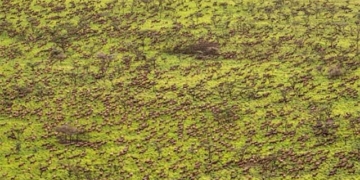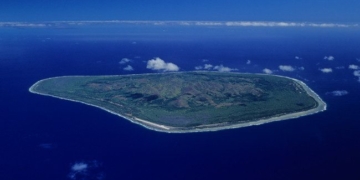Recently, the online community and public opinion have been buzzing with news about a highly venomous snake den appearing on Phu Quy Island, Binh Thuan. So what is the truth about this snake species?
Information About the “Highly Venomous Snake Den” on Phu Quy Island Shakes the Travel Community
As reported by Dan Tri, on April 10, a popular YouTuber shared a video warning about the “highly venomous snake den on Phu Quy Island,” urging everyone to be cautious when traveling to Phu Quy, a tourist destination in Binh Thuan province.
“Everyone visiting Phu Quy Island should be extremely careful, especially young women who often take photos around rocky areas and small pools. This is a nesting site for sea snakes, also known as “dean,” which are very venomous. Not just one nest, but many nests, with about 15-17 snakes in each,” the YouTuber shared in their video.
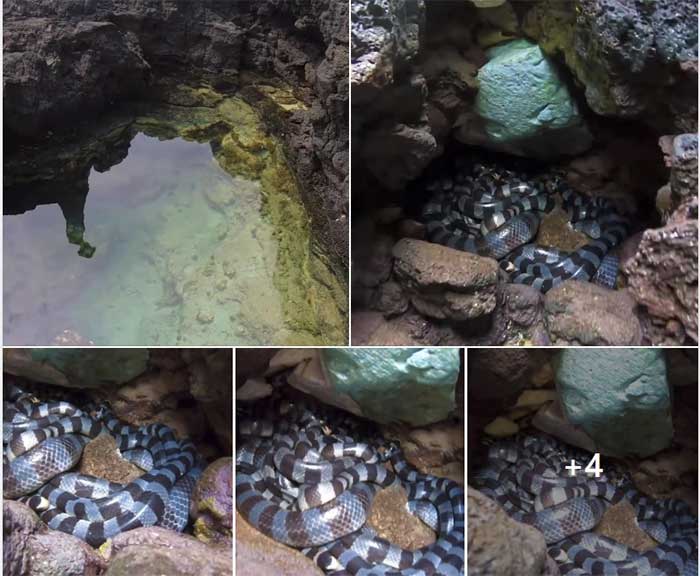
Images of the “highly venomous snake den” causing a stir online. (Screenshot).
The author of the clip stated that he recorded video of the venomous snake den on Hon Den, a small island belonging to Phu Quy Island district on the afternoon of March 28. He claimed this was his first encounter with this snake species and confirmed that it is the most venomous snake in the world.
The information shared by this YouTuber immediately “went viral” on social media. Many large Facebook pages and TikTok accounts shared this information, further alarming the public, especially since Phu Quy is a relatively unspoiled travel destination, ideal for those who love exploration and nature.
Based on the images appearing in the video shared on social networks, it can be determined that these are yellow-margined sea snakes, also known as Laticauda colubrina, a species of sea snake found in tropical waters of the Atlantic and Pacific Oceans.

A yellow-margined sea snake on the beach. (Photo: AZAnimals).
This species features a body with black, gray, or white stripes, a yellow band running along the edge, and a paddle-like tail used for swimming. Female yellow-margined sea snakes are larger than males, with a maximum length of about 1.4 meters. They are often found around coral reefs, mangroves, and shallow waters from depths of 10 meters and above.
Like other sea snakes, yellow-margined sea snakes hunt underwater but return to land to digest food, rest, and reproduce.
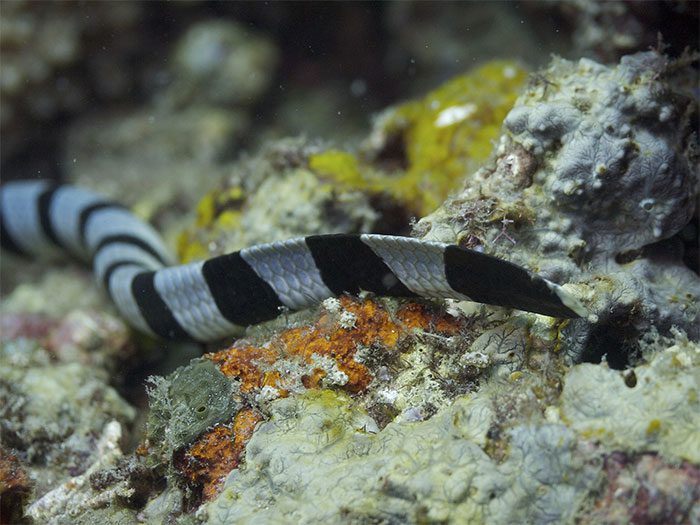
Paddle-like tail of the yellow-margined sea snake. (Photo: Getty).
One distinguishing feature of the yellow-margined sea snake compared to other sea snake species is its mating behavior. While most sea snakes mate underwater, yellow-margined sea snakes not only mate on land but also exhibit collective mating behavior.
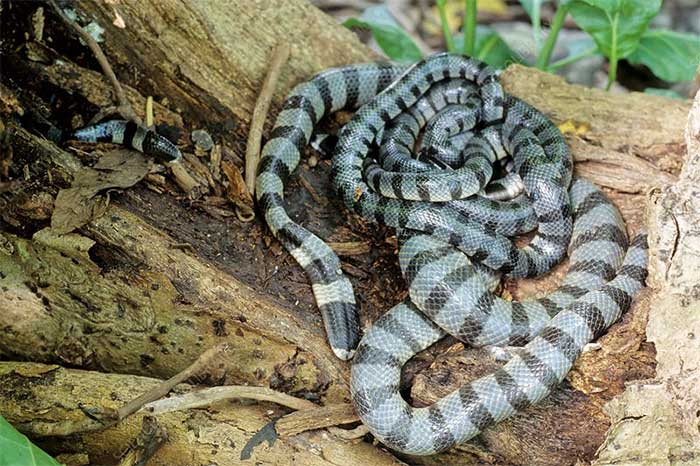
Yellow-margined sea snakes exhibiting collective mating behavior during the breeding season. (Photo: ScienPhoto).
During the mating season, female yellow-margined sea snakes come ashore to attract males. Male snakes chase after females to entice and mate collectively. Yellow-margined sea snakes gather in groups in rock crevices, pools, or along the shore to mate.
This explains why the YouTuber was able to encounter such a crowded snake den.
Are Yellow-Margined Sea Snakes Venomous?
Yellow-margined sea snakes possess highly potent neurotoxic venom, sufficient to kill an adult with a single bite. However, these snakes are very shy, have small fangs, and do not actively attack humans. They only bite when threatened or when humans attempt to capture them.
Most cases of human bites by this snake species involve fishermen trying to disentangle the snakes from fishing nets.
Most sea snake species are very shy and rarely bite humans; they always try to avoid terrestrial animals, including humans.
In fact, most sea snakes have lethal venom and are considered more venomous than land snakes. This is because sea snakes need to hunt fast-swimming fish and eels; thus, they need to evolve venom strong enough to kill their prey rather than chase them in the water.
Since yellow-margined sea snakes specifically, and sea snakes in general, possess lethal venom, visitors swimming in areas where sea snakes are present should keep their distance and absolutely avoid attempting to capture them to prevent unfortunate accidents.
Are Yellow-Margined Sea Snakes Common in Vietnam?
In Vietnam, yellow-margined sea snakes are distributed around Hon Tre Island, Hon Mun Island, in Nha Trang Bay, and Con Cha fishing port in Binh Thuan province.
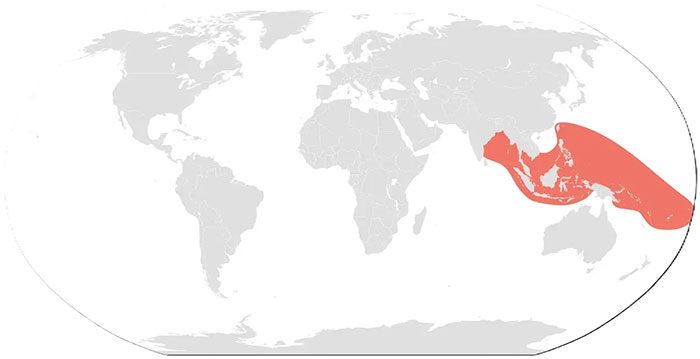
Distribution map of yellow-margined sea snakes. (Photo: Wiki).
However, according to a survey report on sea snakes in Vietnam conducted by the Nha Trang Oceanography Institute and Wildlife at Risk, a non-governmental organization for wildlife conservation, yellow-margined sea snakes are very rarely encountered in Vietnam.
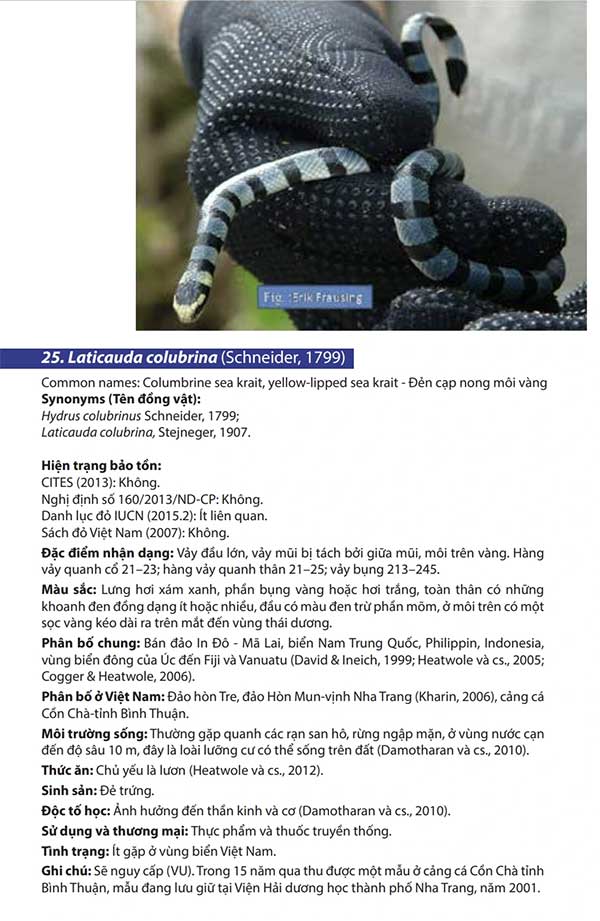
Information about yellow-margined sea snakes in the Survey Report on Sea Snakes in Vietnam. (Photo: Wildlife at Risk).
Before the yellow-margined sea snake den was discovered by the YouTuber on Phu Quy Island, scientists had only obtained one specimen of this snake species at Con Cha fishing port in Binh Thuan, and this specimen is currently preserved at the Nha Trang Oceanography Institute.
Although encounters are rare, it is always wise to remain vigilant and careful when swimming in areas known to harbor sea snakes.
| Phu Quy, also known as Cu Lao Thu or Cu Lao Khoai Xu, is a small island located about 120 km southeast of Phan Thiet, Binh Thuan. |

















































